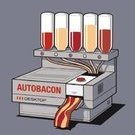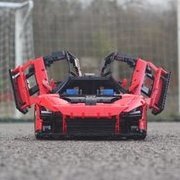-
Content Count
31 -
Joined
-
Last visited
About AutoBacon

Spam Prevention
-
What is favorite LEGO theme? (we need this info to prevent spam)
Technic
Recent Profile Visitors
-
AutoBacon started following [TC25] 8868 Airtech Claw Rig, [Concept] Improve this driven independent front suspension idea!, Truck Trial 56mm competition and and 7 others
-
Greetings, I was tinkering with compact suspensions as I do occasionally, and came upon this; a (9 wide?) concept for a suspended, driven steering system. It's a sort of trailing arm type I guess, and has a floating 'diff' to allow each arm to oscillate independently. I didn't spend very long and this is as far as I've got, it doesn't have room for the driving gears at the moment. As with most technic solutions, if you stare at something long enough, it can usually be made to work :D Thought I could throw it out to you guys to see if anyone can improve upon it. Could be good for some kind fast of 4x4 buggy, the arms and hub interface are quite stiff laterally because of the dual ball pins and turntables. I thought some pushrod spring setup could be cool too.
-

[MOC] Jeep Wrangler 1:13 - Powered Up
AutoBacon replied to gyenesvi's topic in LEGO Technic, Mindstorms, Model Team and Scale Modeling
Awesome build. I love how clean it is :D -

Truck Trial 56mm competition
AutoBacon replied to mahjqa's topic in LEGO Technic, Mindstorms, Model Team and Scale Modeling
Looks great, small and compact but not flimsy. Do you have a stud.io file for it? Can't see how you hooked up the steering motor in such a tight place :D Also can't see how you won't win the next 56mm truck trial :D -

Truck Trial 56mm competition
AutoBacon replied to mahjqa's topic in LEGO Technic, Mindstorms, Model Team and Scale Modeling
Nice work on the front axle. It's interesting working at these small scales, there are only so many designs because there is such little room for excess parts, yet there is always someone to take an idea and make it better :D -

RC Deck - Performance Power Supply With Radio Control
AutoBacon replied to NoEXIST's topic in LEGO Technic, Mindstorms, Model Team and Scale Modeling
This is awesome! I'm wondering if test units will be available for order :D The all in one package looks good for small models, mini crawlers and such. I was wanting a buwizz but I think this is an even better option! -

[MOC] Small scale modular 4x4 RC pickup truck
AutoBacon replied to AutoBacon's topic in LEGO Technic, Mindstorms, Model Team and Scale Modeling
Interesting, thanks for the insight. I wonder now if a linkage system at this scale would offer significant improvements, it seems it would just put more stress on the motor and be less precise than a rack and pinion. I'll have to think about it and do some tests :D I originally used the tractor tires before the RC4WD ones arrived, along with stiffer springs to mitigate wheel rub, and it is true it looks quite good the way they stick out from the body. I agree that perhaps 9 stud axles with custom tires would look pretty good and provide more stability. I'm thinking now that this kind of implies that the body I created is slightly too big, and could so with shrinking, to get the same effect, which would require the omission of the windscreen piece and the wheel arches, as they kind of set the 'minimum scale'. I think I'll try scaling the axles up to 9 studs for the crawler version and trial linkage steering. See how that goes :D -

[MOC] Small scale modular 4x4 RC pickup truck
AutoBacon replied to AutoBacon's topic in LEGO Technic, Mindstorms, Model Team and Scale Modeling
I'm glad you guys like it! I have created a Studio file that contains the fully assembled model and its constituent components, as shown in the render. The file is in my bricksafe folder for the model, which also contains 4 custom parts that you might have to stick in your AppData\Local\Stud.io\CustomParts folder. (the other two parts - one is a 3 stud flip flop beam that Cada makes, and the other is a 3 stud female CV which Studio does not have yet) https://bricksafe.com/pages/autobacon/compact-drivensteered-axle-designs/4x4 Thank you for the positivity! Regarding electronics, I don't currently own any powered-up components, but if I get my hands on a 88009 2 Port hub, angular motor, and an L motor I may try to adapt the model to make it 'more Lego'. I'd like to try using the angular motor as a servo with a pushrod steering setup like Paave used, instead of rack and pinion, I think It could end up being more compact. From the pioneer in quality small-scale RC Lego, thank you :D The tires are 56mm, yes, and also a lot narrower to better suit the scale. Thanks, 1/24 scale crawlers were my main inspiration, I wonder with a lightweight body how close Lego could get to real RC in 1/24, especially when using RC tires. I'm glad you love it :D Thank you. To answer your comments; The shortened arm means the end of the liftarm lines up with the chassis flip-flop beam hole, and you are right, it couldn't be any longer because the steering motor is directly in front of it. Yes, the tires are 56mm, and at the current ride height, they don't rub anywhere in the steering/suspension travel range. This is due to the relatively narrow width compared to 56mm tractor tires, as well as the wheel arch pieces themselves being very thin at the bottom. I think this tire size is the limit of what this fender allows. In terms of suspension, I did play around with weights. Soft springs couldn't really support the body and would allow for too much chassis roll under load, they did give the most flex because once one side of the axle hits the frame, the limit is now how much the opposite spring can stretch. Hard springs didn't really give much flex for crawling. In the end, I got some old medium-weight springs from bricklink, and they seem to be a good middle ground. I think what you are describing in the video is caused by the rearward weight distribution due to the battery position, meaning the model has a bias towards rear suspension flex, and sometimes the front has more to give, it's especially noticeable when the rear axle is loaded. But I do agree with what you are saying. Also something to consider is how small the model is compared to those muddy obstacles, which are nowhere near proportional hehe :D I think before I walk away from this build I might try an alternate build to optimize it for crawling; a super lightweight body, lower the shock towers by a stud for longer travel, and use soft springs for the best flex. Perhaps a simple cabover-style trial truck or a Willy's Jeep. Below you can see the 2L thin liftarm, which acts to counter the downward force when driving forward. Without it, the input shaft mount rolls downwards along the axis drawn with the thick red line. This doesn't cause the gear to slip but the flex means the front and rear axles go out of sync when the front wheels get stopped by an obstacle, as if the front drive axle was connected by a spring to the transfer case. Thanks! I too was pleasantly surprised by the performance with only a single motor! For spring mounting, the spring strength didn't matter too much, I just used my nails to pull down the densely coiled end over the ball joint. It is helpful to put the ball joint in a long liftarm to help hold onto it. Thank you! Regarding the liftarm, there isn't much to show really, I just used a blade to shorten it by a stud and then carefully cut the rough edges away. You can see it in the close-up of the rolling chassis in the video :D -

[MOC] Small scale modular 4x4 RC pickup truck
AutoBacon posted a topic in LEGO Technic, Mindstorms, Model Team and Scale Modeling
Greetings. I would like to present my first completed model; a small-scale remote-controlled pickup truck. Featuring 4x4 drive, 3-Link suspension front & rear, 7-stud wide axles, no old-style CVs, and a fully modular body/chassis. I had a few goals with this project; Produce the smallest possible scale 4x4 whilst retaining realistic proportions Use as few parts as possible System body for detail and smoothness This project began as a test platform for an improved 7-stud wide driven front axle design taken from my WIP KrAZ project I started last year. I wasn't happy with the unreliability of old cv joints, and weak rubber-sprung axles, so I embarked on a quest to fix these issues. I realized I could fit new CV joints after seeing @apachaihapachai's Terracotta Pickup Truck, this massively improved the load capacity and reliability, while making the overall package smaller, making me confident the axle was now strong enough to support a brick-built body. Next was the suspension, I needed real springs instead of 45590 rubber pieces. After some pondering, I discovered that I could take springs out of regular shock absorbers, and keep them in place with ball joint pins. The suspension now had great support and range of motion. I made the rear axle with as few parts as possible, it flexes a little but it is strong enough to handle a small model such as this one. I wanted to keep it as simple as possible to keep the level of bulk to a minimum. Below is the final chassis. Because the axles are only 2 studs high, the chassis can be nice and low, while still giving one stud of vertical suspension compliance. What I found with really small models, is the motors tend to get put in strange places and often become structurally integral in order to keep the model small. To keep with the ethos of this build, I wanted the drive and steering motors to be concealed within the chassis rails, while also being easily removable, and using the fewest gears possible. The result is a drive motor/transfer case with an integrated steering motor. It is mounted directly to the chassis with just 4 pins. The model is powered by a MouldKing battery mounted in the cargo bed, feeding power to the L motor for drive, and Cada micro motor for steering. The final drive geared down 1.67:1 from the motor, and with a total weight of about 650g, this gives a good mixture of torque and speed. The Cada micro motor is slow enough that it can be used to directly drive the steering rack, as long as you have a proportional controller. As well as the suspension solution, there are a couple of modified parts; namely a shortened suspension arm with tow ball for the rear axle, and a 2L half-thick liftarm to improve the front drive input shaft rigidity. Regarding the body design, I decided to try using the new wheel arches from the Camero set. I hoped these pieces could result in a body that wasn't outrageously heavy but still had a good level of detail. I needed to keep the design simple as this is the first time I've created a body, I don't usually get past the chassis in my builds. The proportions and style of the design were based loosely on a 70s Chevy k20, although the arches are a little too big. I ended up liking how the side panels could be removed completely in one piece each, and the rest of the body plugged into the chassis with 2 pins per section for easy removal. Anyway, thanks for reading, any feedback regarding the build/presentation is welcome. Check out the video for a closer look and to see its capabilities with some outdoor driving. -

Third Party Tires for Lego Technic Rims
AutoBacon replied to efferman's topic in LEGO Technic, Mindstorms, Model Team and Scale Modeling
This is exactly how the truck is made :D- 703 replies
-
- where can I buy these wheels
- Third Party
-
(and 3 more)
Tagged with:
-

Third Party Tires for Lego Technic Rims
AutoBacon replied to efferman's topic in LEGO Technic, Mindstorms, Model Team and Scale Modeling
Indeed, one L motor has enough power to move 650g model easily, even with only one down-gearing of 12/20t in the axles, and the tyres have really good deformation with this weight. The fenders come in black on the new Camero, and lime green on some other themed set. This was a bit of a test platform for an improved axle and suspension originating from my wip kraz, I hope to post soon the results!- 703 replies
-
- where can I buy these wheels
- Third Party
-
(and 3 more)
Tagged with:
-

Third Party Tires for Lego Technic Rims
AutoBacon replied to efferman's topic in LEGO Technic, Mindstorms, Model Team and Scale Modeling
I have just received the Falken Wildpeak M/T 1.0" tyres I ordered from RC4WD. Posting them here if anyone is interested in how they compare to stock Lego tyres. They measure 56mm x 19mm and fit perfectly on the 30x14mm rims. They are super soft, so with a slightly heavier model they deform a lot which is great for grip. They have transformed the performance of the small RC 4x4 I am working on, and they also suit the scale better than the tractor tyres due to the narrower width.- 703 replies
-
- where can I buy these wheels
- Third Party
-
(and 3 more)
Tagged with:
-

Third Party Tires for Lego Technic Rims
AutoBacon replied to efferman's topic in LEGO Technic, Mindstorms, Model Team and Scale Modeling
The last video is perfect, I was looking for some info on the smaller rc4wd tyres the other day! I've ordered the Falken Wildpeak M/T 1.0", 56mm tyre for a 7 stud wide axle 4x4 I'm working on. It has a brick-built body so it should be heavy enough (it's basically finished and about 650g) to take advantage of the grippier tyres as you mentioned in the video. I'll post the results when they arrive in a week or so.- 703 replies
-
- where can I buy these wheels
- Third Party
-
(and 3 more)
Tagged with:
-

[CADA] CADA General Discussion Topic
AutoBacon replied to Milan's topic in LEGO Technic, Mindstorms, Model Team and Scale Modeling
Hi, I noticed on the Mouldking mobile crane 17013 that one of the advertised features is the use of a custom-style CV joint. It looks to me that the male end is the same size as the old Lego CV joint but is slotted and therefore stronger like the new Lego version. Does anyone have any experience with them and if so know where to find them individually? -

Pneumatic pressure switch using current parts
AutoBacon replied to ord's topic in LEGO Technic, Mindstorms, Model Team and Scale Modeling
Would it help to have a spring in the opposite direction of the small cylinder? -

[MOC] Off-road truck Gaz 66[instructions available]
AutoBacon replied to keymaker's topic in LEGO Technic, Mindstorms, Model Team and Scale Modeling
I like this a lot. A very challenging scale. Good job.




